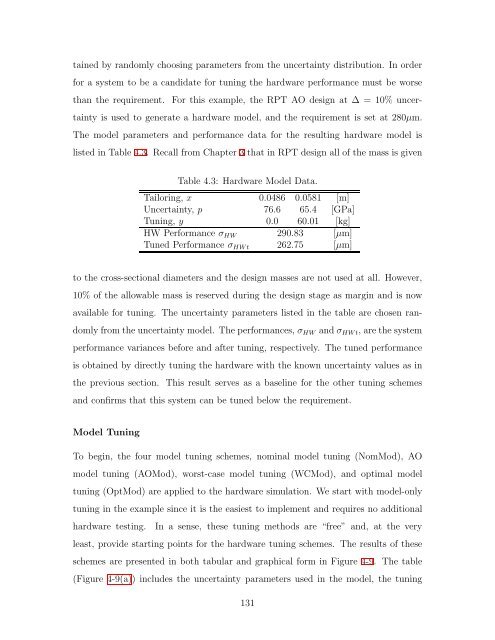Chapter 5 Robust Performance Tailoring with Tuning - SSL - MIT
Chapter 5 Robust Performance Tailoring with Tuning - SSL - MIT
Chapter 5 Robust Performance Tailoring with Tuning - SSL - MIT
You also want an ePaper? Increase the reach of your titles
YUMPU automatically turns print PDFs into web optimized ePapers that Google loves.
tained by randomly choosing parameters from the uncertainty distribution. In order<br />
for a system to be a candidate for tuning the hardware performance must be worse<br />
than the requirement. For this example, the RPT AO design at ∆ = 10% uncer-<br />
tainty is used to generate a hardware model, and the requirement is set at 280µm.<br />
The model parameters and performance data for the resulting hardware model is<br />
listed in Table 4.3. Recall from <strong>Chapter</strong> 3 that in RPT design all of the mass is given<br />
Table 4.3: Hardware Model Data.<br />
<strong>Tailoring</strong>, x 0.0486 0.0581 [m]<br />
Uncertainty, p 76.6 65.4 [GPa]<br />
<strong>Tuning</strong>, y 0.0 60.01 [kg]<br />
HW <strong>Performance</strong> σHW 290.83 [µm]<br />
Tuned <strong>Performance</strong> σHWt 262.75 [µm]<br />
to the cross-sectional diameters and the design masses are not used at all. However,<br />
10% of the allowable mass is reserved during the design stage as margin and is now<br />
available for tuning. The uncertainty parameters listed in the table are chosen ran-<br />
domly from the uncertainty model. The performances, σHW and σHWt, are the system<br />
performance variances before and after tuning, respectively. The tuned performance<br />
is obtained by directly tuning the hardware <strong>with</strong> the known uncertainty values as in<br />
the previous section. This result serves as a baseline for the other tuning schemes<br />
and confirms that this system can be tuned below the requirement.<br />
Model <strong>Tuning</strong><br />
To begin, the four model tuning schemes, nominal model tuning (NomMod), AO<br />
model tuning (AOMod), worst-case model tuning (WCMod), and optimal model<br />
tuning (OptMod) are applied to the hardware simulation. We start <strong>with</strong> model-only<br />
tuning in the example since it is the easiest to implement and requires no additional<br />
hardware testing. In a sense, these tuning methods are “free” and, at the very<br />
least, provide starting points for the hardware tuning schemes. The results of these<br />
schemes are presented in both tabular and graphical form in Figure 4-9. The table<br />
(Figure 4-9(a)) includes the uncertainty parameters used in the model, the tuning<br />
131







